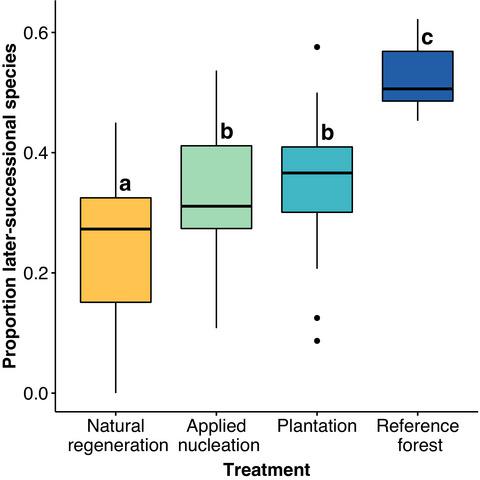当前位置:
X-MOL 学术
›
J. Appl. Ecol.
›
论文详情
Our official English website, www.x-mol.net, welcomes your feedback! (Note: you will need to create a separate account there.)
Degree of intervention affects interannual and within-plot heterogeneity of seed arrival in tropical forest restoration
Journal of Applied Ecology ( IF 5.7 ) Pub Date : 2021-05-11 , DOI: 10.1111/1365-2664.13907 Leland K. Werden 1 , Karen D. Holl 2 , Jose Miguel Chaves‐Fallas 3, 4 , Federico Oviedo‐Brenes 5 , Juan Abel Rosales 5 , Rakan A. Zahawi 1, 2
中文翻译:

干预程度影响热带森林恢复中种子到达的年际和小区内异质性
更新日期:2021-05-11
Journal of Applied Ecology ( IF 5.7 ) Pub Date : 2021-05-11 , DOI: 10.1111/1365-2664.13907 Leland K. Werden 1 , Karen D. Holl 2 , Jose Miguel Chaves‐Fallas 3, 4 , Federico Oviedo‐Brenes 5 , Juan Abel Rosales 5 , Rakan A. Zahawi 1, 2
Affiliation

|
- In degraded tropical landscapes, lack of seed dispersal can strongly limit recovery, and restoration interventions can overcome this barrier by attracting dispersers. However, seed dispersal patterns are typically studied over short time periods, thus the influences of temporal and spatial variability on seed arrival cannot be teased apart.
- The choice of management approach can have important implications for restoration-mediated community reassembly. Accordingly, we used a 3.5-year record of seed deposition in pre-montane tropical wet forest in southern Costa Rica to examine how seed arrival differed between passive (natural regeneration) and active (applied nucleation, plantation) restoration after a decade of recovery, compared to remnant forest. We investigated: (a) how restoration treatments affected seed deposition rates and community composition; (b) how within-plot heterogeneity of animal-dispersed seed deposition varied by intervention; and (c) how interannual variation influenced animal-dispersed seed arrival across treatments.
- Overall seed rain composition and diversity in restoration treatments was converging towards, but still differed substantially from, remnant forest (89.7%, 86.6% and 76.3% Shannon diversity recovered in applied nucleation, plantation and natural regeneration respectively).
- Within-plot animal-dispersed seed heterogeneity was similar in applied nucleation and remnant forest, 27.0% more heterogeneous in applied nucleation than plantation, and equivalent when comparing natural regeneration to either applied nucleation or plantation.
- In contrast to active interventions, animal-dispersed tree and shrub communities did not differ year to year in natural regeneration, which may promote the assembly of relatively homogeneous plant communities at this successional stage.
- Synthesis and applications. Compared to natural regeneration, active restoration interventions: (a) catalysed the recovery of seed diversity (overall Shannon diversity 17.5% and 13.4% higher in applied nucleation and plantation respectively), (b) shifted seed community composition towards remnant forest more rapidly (overall Shannon diversity 13.4% and 10.2% closer), (c) almost doubled the proportion of later-successional tree species arriving, and (d) had seed communities that differed year to year—a pattern not observed in natural regeneration. Finally, applied nucleation was the only intervention where seed arrival was as spatially heterogeneous as remnant forest, highlighting that this approach may facilitate the recovery of specific natural dispersal processes.
中文翻译:

干预程度影响热带森林恢复中种子到达的年际和小区内异质性
- 在退化的热带景观中,缺乏种子传播会严重限制恢复,恢复干预可以通过吸引传播者来克服这一障碍。然而,种子传播模式通常是在短时间内研究的,因此时空变异对种子到达的影响无法分开。
- 管理方法的选择对恢复介导的社区重组具有重要意义。因此,我们使用哥斯达黎加南部前山地热带湿林中 3.5 年的种子沉积记录来研究经过十年的恢复后种子到达在被动(自然再生)和主动(应用成核、种植)恢复之间的差异,与残林相比。我们调查了:(a)恢复处理如何影响种子沉积率和群落组成;(b) 动物散播种子沉积的小区内异质性如何因干预而变化;(c) 年际变化如何影响不同处理间动物分散的种子到达。
- 恢复处理中的整体种子雨组成和多样性向残余森林趋同,但仍存在很大差异(分别在应用成核、人工林和自然更新中恢复了 89.7%、86.6% 和 76.3% 的香农多样性)。
- 小区内动物分散种子异质性在应用成核和残留林中相似,应用成核的异质性比人工林高 27.0%,并且在将自然再生与应用成核或人工林进行比较时相当。
- 与积极干预相反,动物散布的乔木和灌木群落在自然更新方面逐年没有差异,这可能会促进在这个演替阶段相对同质的植物群落的组装。
- 合成与应用。与自然更新相比,积极的恢复干预措施:(a)促进种子多样性的恢复(整体香农多样性分别在应用成核和人工林中分别高出 17.5% 和 13.4%),(b)将种子群落组成更快地转移到残余森林(总体而言)香农多样性增加 13.4% 和 10.2%),(c) 后继树种到达的比例几乎翻了一番,(d) 种子群落每年都不同——这种模式在自然更新中没有观察到。最后,应用成核是种子到达与残余森林一样具有空间异质性的唯一干预措施,强调这种方法可能有助于特定自然传播过程的恢复。


























 京公网安备 11010802027423号
京公网安备 11010802027423号